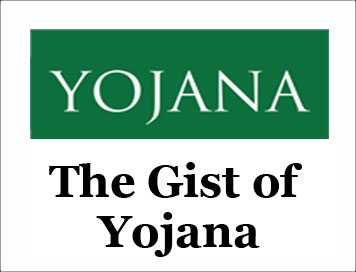(HOT) UPSC Current Affairs 2025 PDF
NEW! The Gist (NOV-2025) | E-BOOKS
(GIST OF YOJANA) India’s Turf: A Global Investor Haven
GIST OF YOJANA : India’s Turf: A Global Investor Haven
APRIL-2025
India’s Turf: A Global Investor Haven
Context:
Government aims to transform India from a cash-strapped economy into a thriving one. Prioritising ease of doing business, a robust investment climate, and enhancing India’s global competitiveness have been central to this vision.
India has gained global recognition for its economic growth, technological advancements, and contributions to global stability and established a dynamic and robust investment climate.
This progress aligns seamlessly with the ambitious vision of a ‘Viksit Bharat @2047’ positioning the nation as an indispensable force in the global landscape.
What Have Been the Progressive Trends?
Managing the aspirations of over 1.4 billion citizens, India’s leadership identified that the nation’s economic trajectory depends on cultivating homegrown solutions, rather than depending on imports. The focus has been on:
-
Prioritising domestic production.
-
Ensuring fair royalties for intellectual property.
-
Active promotion of local manufacturing of finished goods.
-
These strategic efforts, combined with increasing global endorsements from international leaders, were leveraged further to attract resources that fuel India’s growth story, positioning the nation as a leading investment hub in the global economy.
-
According to the 2024 PwC 27th Global CEO Survey, India has risen to fifth place globally as an investment destination, up from ninth in 2023, reflecting investor confidence and trust in its future growth.
-
The survey was conducted across 105 countries with participation from nearly 5000 CEOs.
Highlights on the Opinion of Indian CEOs on Domestic Turf:
-
According to the PwC Survey. there exists a significant increase in optimism among Indian CEOs, with 86% expecting economic Improvement
-
Indian CEOs have shown a 30% increase in confidence our nation growth potential compared to 2023.
-
They also have higher revenue growth expectations over the next 12 months.
-
Furthermore, they agree that India is on track to become the third-largest global economy by 2030.
-
Increased focus on technological innovations, including Generative AI remains the prime driver of this growth expectation and business reinvention.
Statistical Evidence for Outcomes of Regulatory Support for Encouraging FDI & Ease of Doing Business Reforms
Strategy & Approach: Focus on global competitiveness driven by reduced regulatory friction and fostering trust. The key steps:
-
Promote ‘Make in India’
-
Liberalise Sectoral Policies and
-
Introduce tax reforms, especially the Goods and Services Tax (GST)
-
Compliance burden reduced
-
Provisions decriminalised effectively
-
Single-window system launched
Outcomes
-
Strong FDI inflows across diverse sectors.
-
A thriving IPO market.
-
Enhanced participation from retail investors through SIPs.
Impact of FDI Liberalisation
-
Decadal cumulative FDI (2014-24) has risen by 119% over the previous decade.
-
India attracted $991 billion in FDI between 2000-2024, with 67% ($667 billion) coming in the last decade.
-
FDI in the manufacturing sector saw a 69% increase, rising from $98 billion (2004-2014) to $165 billion (2014-2024).
Impact of Ease of Doing Business Reforms
-
According to the KPMG report on IPO in India, in the first half of FY25 IPO funds raised were more than doubled compared to FY24, indicating a surge in market activity and investor confidence.
-
India's inclusion in one of the US’s lending banks’ global government bond index stands out in the first half of FY 25 made significant news during this time.
-
This growth reflects the resilience of India’s capital markets, driven by a strong economic environment and widespread investor interest across sectors.
-
This trend stands out as India’s IPO market remained robust in HI FY25, continuing the momentum from FY24 despite geopolitical uncertainties.
-
The strong retail investor participation in IPOs, oversubscription trends, and a favorable regulatory environment validate the demonstrated resilience of the Indian economy as shown by SIP trends.
Ripple Effects for The Economy
-
These projects have boosted India’s industrial capabilities and supported job creation.
-
The ripple effect of such investments flows to India’s nearly 6 crore MSMEs integral to the supply chains, with their employment reaching 24 crore by the end of December 2024 from 10 crore In 2012-13.
-
For the economy overall, 17.9 crore additional job, were created during PM Modi’s tenure.
-
As large-scale Infrastructure, energy, and technology projects expand, MSMEs gain from increased demand for ancillary services, materials, and Innovations.
-
Skill development enhanced market linkages and greater financial inclusion for small businesses. The new governance benchmarks set since 2014 have notably enhanced India’s economic growth and soft power, building on earlier foundations and positioning India as a stronger global player.
Conclusion and Way forward:
The favourable policy framework and continued infrastructure investment contribute to sustained growth, reinforcing India’s position as a promising investment destination.
This strengthened the bedrock for India’s emergence as a global investment hub. As a result, the international communities resonate more with the vision of ‘Viksit Bharat @ 2047’.
CLICK HERE TO DOWNLOAD FULL PDF
CLICK HERE TO DOWNLOAD UPSC E-BOOKS
Study Material for UPSC General Studies Pre Cum Mains
Get The Gist 1 Year Subscription Online
Click Here to Download More Free Sample Material
<<Go Back To Main Page
Courtesy: Yojana



